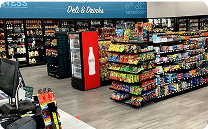In This article
Inventory shrinkage is a continuous challenge for businesses that manage physical products, especially in retail, food service, warehousing, and logistics sectors. It represents the difference between recorded inventory and what is physically available and signals that something has gone wrong in the supply chain, storage process, or sales floor.
What Causes Inventory Shrinkage?
Shrinkage affects more than just stock levels. It can erode profit margins, disrupt reordering processes, mislead demand forecasting, and negatively influence overall business performance. Understanding the root causes of inventory shrinkage is key to reducing loss and maintaining accurate, efficient operations.
Common causes of inventory shrinkage include:
- Employee theft, such as stealing merchandise or manipulating inventory counts to conceal missing items.
- Customer theft, often called shoplifting, can be challenging to detect without surveillance or attentive staff.
- Administrative errors, including receiving, pricing, labelling, or tracking inventory mistakes.
- Supplier fraud, occurs when vendors deliver fewer goods than invoiced or substitute products without proper documentation.
- Damaged or expired goods, especially in perishable inventory categories like food and pharmaceuticals.
Each of these causes can lead to stock discrepancies that may not be discovered until a cycle count or full audit is conducted. By that time, the opportunity to identify the source of the loss may have passed, making proactive monitoring essential.
Steps to Reduce Inventory Shrinkage
Businesses often combine process improvements, employee training, and technology to reduce shrinkage. These may include:
- Conducting regular inventory audits or cycle counts.
- Establishing clear receiving and documentation procedures.
- Using surveillance cameras in stockrooms, receiving bays, and sales floors.
- Integrating point-of-sale (POS) data with inventory management systems for better tracking.
- Limiting access to inventory storage areas through access control systems.
- Training staff to recognize suspicious behavior or procedural gaps.
Surveillance plays a critical role in identifying when and where shrinkage occurs. Video footage linked to specific periods, transaction data, or access logs can help confirm whether losses are due to operational mistakes or intentional theft. In many cases, pairing visual evidence with inventory and sales reports provides a clearer understanding of shrinkage patterns.
Businesses that experience chronic inventory shrinkage may also need to evaluate vendor relationships, internal controls, and staffing procedures. Inconsistent inventory levels across locations or shifts may point to specific vulnerabilities that require targeted attention.
The cost of shrinkage adds up quickly. Lost products translate directly into lost revenue, and repeated issues may require additional labor, training, or security investments. While some shrinkage is expected in most industries, unmanaged shrinkage can seriously affect profitability and resource allocation.
Reduce Shrinkage with DTiQ
The DTiQ 360iQ platform helps businesses detect and investigate inventory shrinkage by combining video surveillance and transaction data, providing insights in one connected platform. Whether losses are due to theft, errors, or supplier issues, DTiQ loss prevention solutions give you the visibility and tools to pinpoint the problem, protect your stock, and improve inventory accuracy across all your locations. Contact us to speak with a loss prevention expert.




























